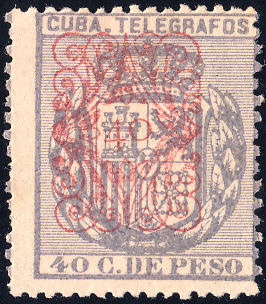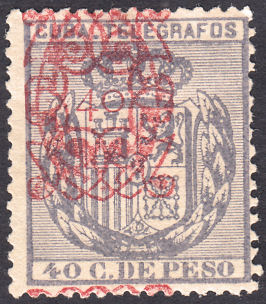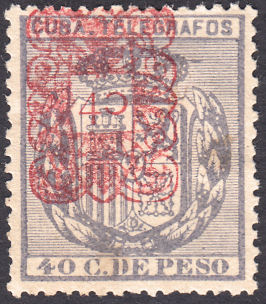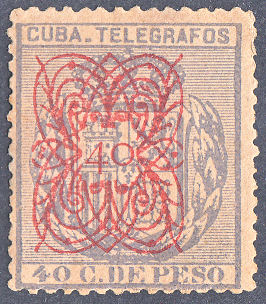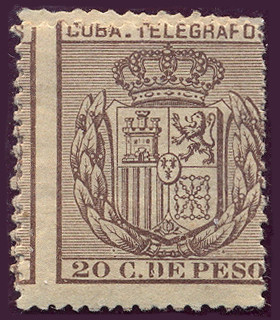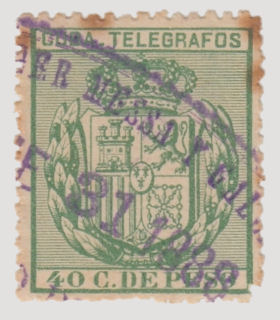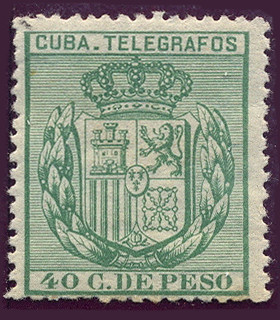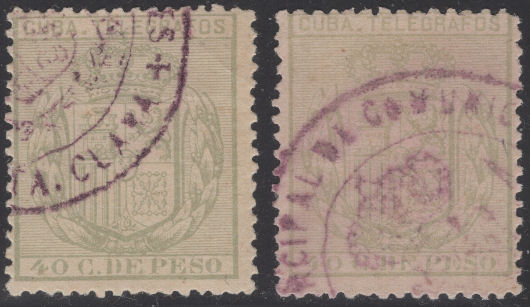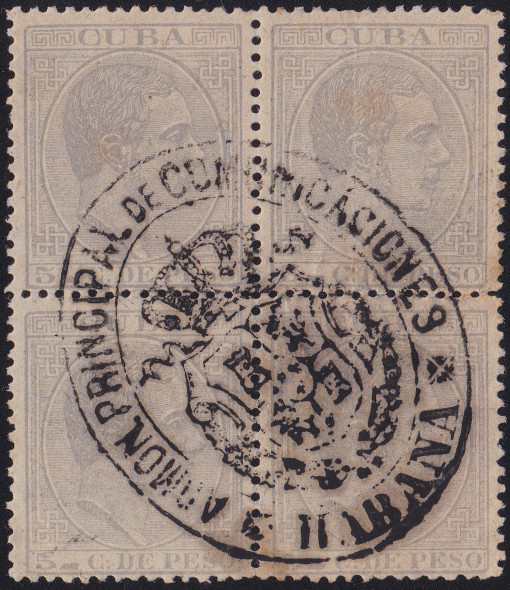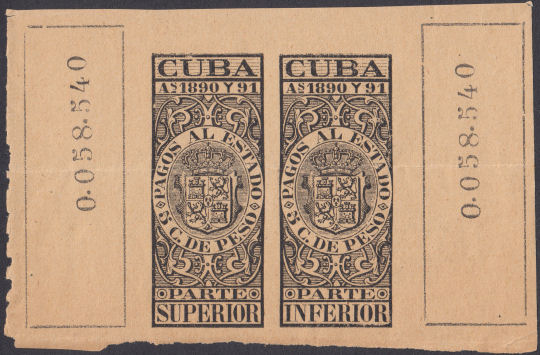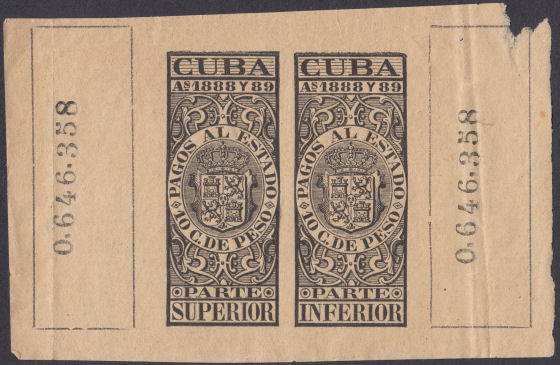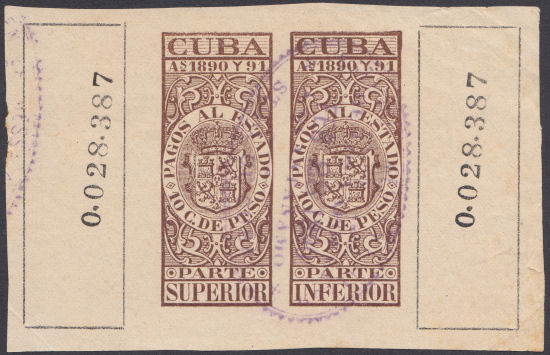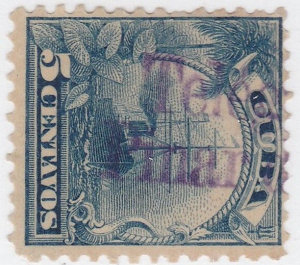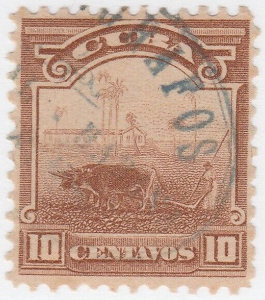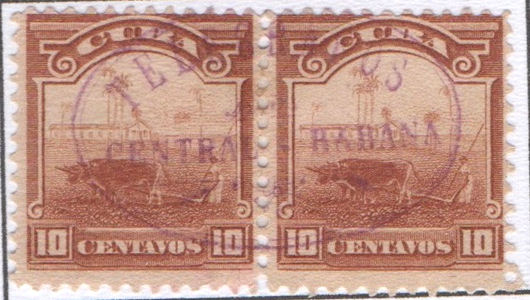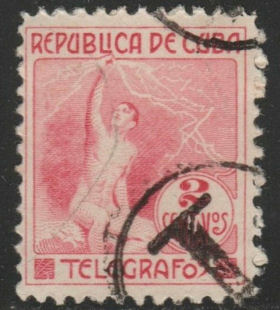| Up a level | ||||||||||
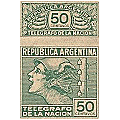 |
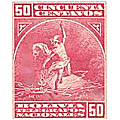 |
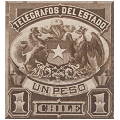 |
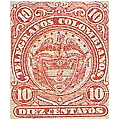 |
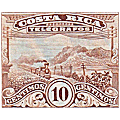 |
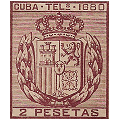 |
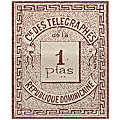 |
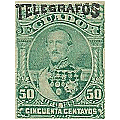 |
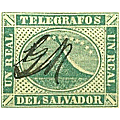 |
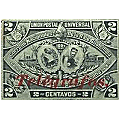 |
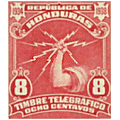 |
| Argentina | Bolivia | Chile | Colombia | Costa Rica | Cuba | Dominican Rep. | Ecuador | El Salvador | Guatemala | Honduras |
| Up a level | ||||||||||
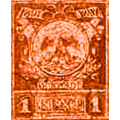 |
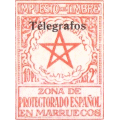 |
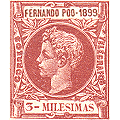 |
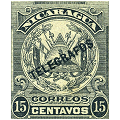 |
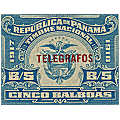 |
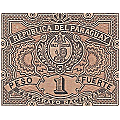 |
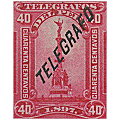 |
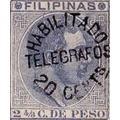 |
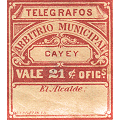 |
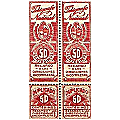 |
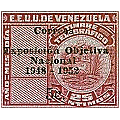 |
| Mexico | Morocco | Guinea | Nicaragua | Panama | Paraguay | Peru | Philippines | Puerto Rico | Uruguay | Venezuela |
Contributors: |
I have brought these prices up to date and added currency selection. I have added Correos y Telegrafos stamps at the end for those who choose to collect them. I have used 'RH' numbers (Revised Hiscocks) for these to avoid conflicts. CheckList Setup |
| Shortcuts to different sections | |||||||||||
| 1868+ | 1870+ | 1875+ | 1876 | 1877+ | 1882+ | 1884+ | 1897+ | 1910+ | Other | Telephone Stamps | Stationery |
Cuba.
Steve Hiscocks wrote:
Apart from frequent changes of currency the telegraph stamps of Cuba are up to 1898, typical of those of Spanish colonies progressing through those of
Isobel II, arms types reflecting various changes in Spain. Alfonso XII, and arms again. The revolution of 18 September, 1868, which removed Isobel II,
gave rise to a set of provisionals as with postage stamps. In 1874 and 1889-90 telegraph stamp shortages gave rise to the use of fiscals as noted below.
Cuba rebelled in 1898 and became an independent republic in 1902. It is not known what, if any, stamps were used for the prepayment of telegrams
between 1898 and 1902 or in the early republican era up to 1910 when the first republican telegraph stamps were issued. The last issue, that of 1916,
was apparently in use for eight years until telegraph stamps were discontinued on 1 January 1924: they are surprisingly scarce.
|
"In the year 1851 Mr. Samuel Kennedy was granted authorization to establish a telegraph line in Havana, between the Villanueva theatre and the Plaza Monserrate I understand. The telegraph lines appear to have grown with the rail network and extended throughout the length and breadth of the island. It should be noted that the telegraph service, like the rail service, was implemented in Cuba before it was in Spain. According to Bill Glover : Captain James Alexander Scrymser applied to the Florida State Legislature for the rights to land a cable at Punta Rassa(W.Florida); this was granted for a period of twenty years. At the same time General William F. Smith applied to the Cuban Government for similar cable landing rights in Cuba; this was granted for a period of forty years. The success of these two applications led to the formation of the International Ocean Telegraph Company. An Act of Congress passed on 5 May 1866 granted the company exclusive rights to operate all Cuban traffic for a period of fourteen years. At the same time exclusive rights to operate a private landline between Punta Rassa and Lake City(N. Florida) was also granted. At Lake City the line linked with Western Union’s network. ------- In 1867 a maritime cable was laid between Cuba and Florida, and in 1868 the necessary permits were granted to extend them to Puerto Rico, Mexico, Panama and the north coast of South America. The war of 1868-78 required the civilian telegraph network to be used by, and extended by the military. By the year 1879 there were 172 telegraphic stations in Cuba with five main offices: Havana, Santa Clara, Port-au-Prince(now Camagüey), Victoria de las Tunas and Santiago de Cuba. The Royal Decree of May 29, 1884, published in the Official Gazette of Havana on June 24 of the same year, provided that the postal and telegraph services should be united in one, and that both, with the denomination of Corps of Communications, were under the direction of a General Administrator ". According to atlantic-Cable.com, from 1870-73 cables for the West India & Panama Telegraph Co. were laid accordingly: Santiago de Cuba Holland Bay, Jamaica Colon, Panama. Jamaica San Juan, Puerto Rico St. Thomas St. Kitts Antigua Guadeloupe Dominica Martinique St. Lucia St. Vincent Barbados. St. Vincent Grenada Trinidad British Guiana. According to Bill Glover, in 1888, La Société Française de Télégraphes Sous-Marin had Cables laid by CS Westmeath from : Santiago de CubaGuantanamo, Cuba 50 nm Guantanamo, CubaSt Nicholas Mole, Haiti 125 nm St Nicholas MoleCap Haitien, Haiti 96 nm Cap HaitienPuerto Plata, Dominican Republic 116 nm In 1896, according to the Naval History and Heritage Command, a cable-cutting recommendation contained "Cable communication with the island should be promptly cut off at Guanabano and Santiago de Cuba. It would also be well to cut the cables entering Cienfuegos." (Despite having ratified the Convention for the Protection of Submarine Telegraph Cables in 1885.) Cables were subsequently cut in 1898. Together, these two references give us the locations of the cables. Havana connected only to Key-West, Florida. A cable to Batabano which connected by train and telegraph to Havana. Batabano to San Luis, Cienfuegos, Trinidad, Santiago de Cuba, and Guantanamo Bay. Santiago de Cuba is connected with Jamaica(Kingston) by cable, and Guantanamo with Haiti. I cannot find a place by the name of Guanabano on the coast, but I have marked one that I could find. A list of 1906 for wireless-Telegraph stations lists the US Navy as having one at Guantánamo. A similar list for 1910 shows additional Commercial installations at Cape San Antonio and Havana(Vedado), as well as Government installations at Baracoa, Bayamo, Camaguey, Cayo Criso, Havana(Morro Castle), Isle of Pines, Nueva Gerona, Pinar del Rio, Santa Clara and Santiago de Cuba. This is here to get consistent results on different browsers. |
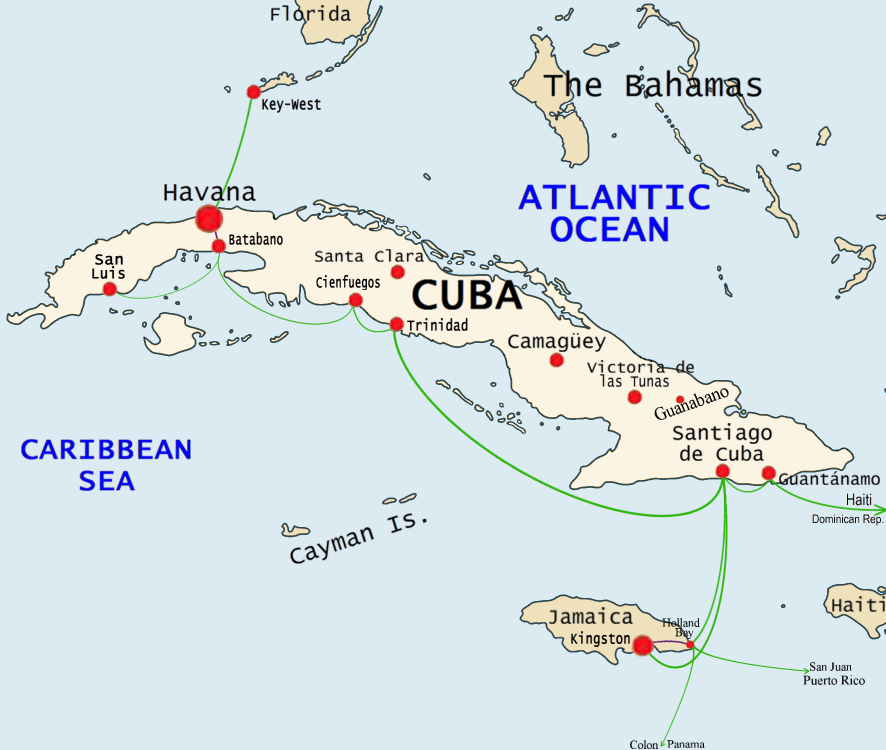
1868 Isabel II. Wove paper. No watermark. Perf. 14 (1000 Mils = 1 Escudo).
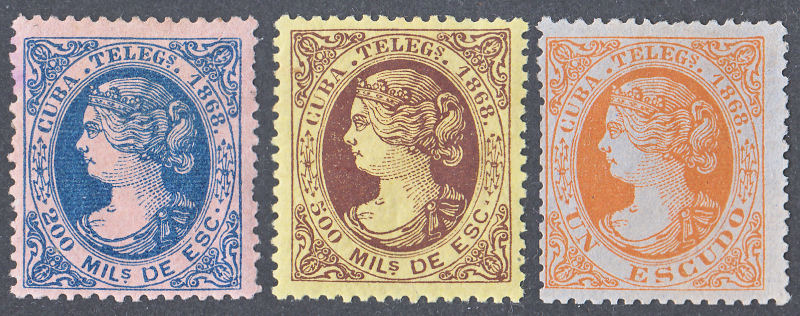 |
| Type 1, 1868 set |
| Hisc. | Type. | 1868 Description | Mint | Used |
|---|---|---|---|---|
| H1 | 1 | 200m indigo on pink | 7.50 | 4.00 |
| H2 | 1 | 500m chocolate on yellow | 7.50 | 4.00 |
| H3 | 1 | 1E orange on pale blue | 15.00 | 4.00 |
1869 As above but dated 1869. White paper.
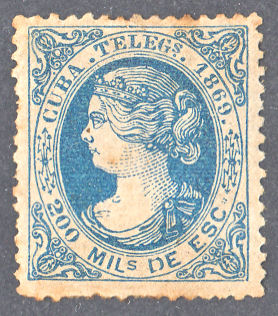 |
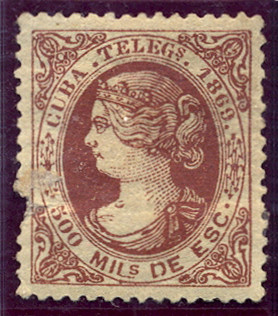 |
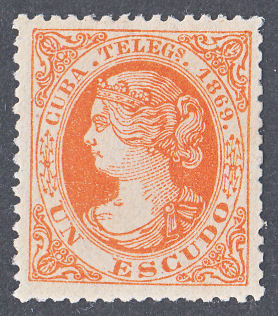 |
| Type 2 H4 | Type 2 H5 - from RL. | Type 2 H6 |
| Hisc. | Type. | 1869 Description | Mint | Used |
|---|---|---|---|---|
| H4 | 2 | 200m deep dull blue | 30.00 | 10.00 |
| H5 | 2 | 500m red-brown | 30.00 | 10.00 |
| H6 | 2 | 1E orange | 35.00 | 10.00 |
1869 As above (Nos. 4-6) but overprinted as type 3 in black or blue as indicated.
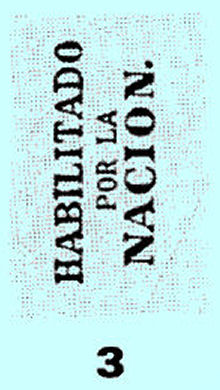 |
 |
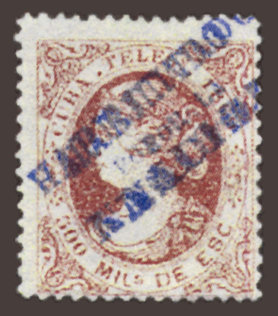 |
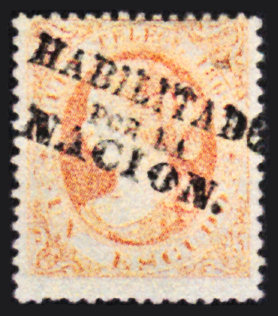 |
| Type 3 from Hiscocks page 81 together with a more usual orientation. |
H10 courtesy of John Barefoot. |
H11b courtesy of John Barefoot. |
| Hisc. | Type. | Description | Mint | Used |
|---|---|---|---|---|
| H7 | 2, 3 | 200m deep dull blue, overprinted in black | 75.00 | 35.00 |
| H7a | overprinted inverted (reading down) | 80.00 | 40.00 | |
| H8 | 2, 3 | 200m deep dull blue, overprinted in blue | 75.00 | 35.00 |
| H8a | overprinted inverted (reading down) | 80.00 | 40.00 | |
| H9 | 2, 3 | 500m red-brown, overprinted in black | 75.00 | 35.00 |
| H9a | overprinted inverted (reading down) | 80.00 | 40.00 | |
| H10 | 2, 3 | 500m red-brown, overprinted in blue | 75.00 | 35.00 |
| H10a | double overprint | 150.00 | 75.00 | |
| H10b | overprinted inverted (reading down) | 80.00 | 40.00 | |
| H11 | 2, 3 | 1E orange, overprinted in black | 75.00 | 35.00 |
| H11a | double overprint | 150.00 | 75.00 | |
| H11b | overprinted inverted (reading down) | 80.00 | 40.00 | |
| H12 | 2, 3 | 1E orange, overprinted in blue | 75.00 | 35.00 |
| H12a | double overprint | 150.00 | 75.00 | |
| H12b | overprinted inverted (reading down) | 80.00 | 40.00 |
These overprints can be found at all angles. The term 'inverted' should be interpreted liberally.
Hiscocks added the following note:
| Note. The above overprints were occasioned by the revolution of 18 September 1868 in Spain, which resulted in the removal of Isobel II. |
1870 New design. White wove paper. No watermark. Perf. 14.
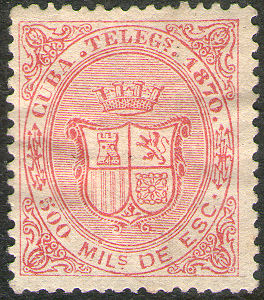 |
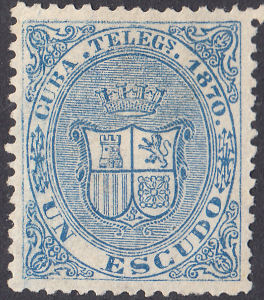 |
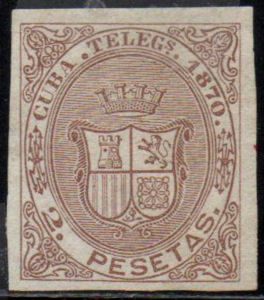 |
| Type 4 H14 | Type 4 H15 | Type 4 H16a courtesy of Madios. Click image for listing. |
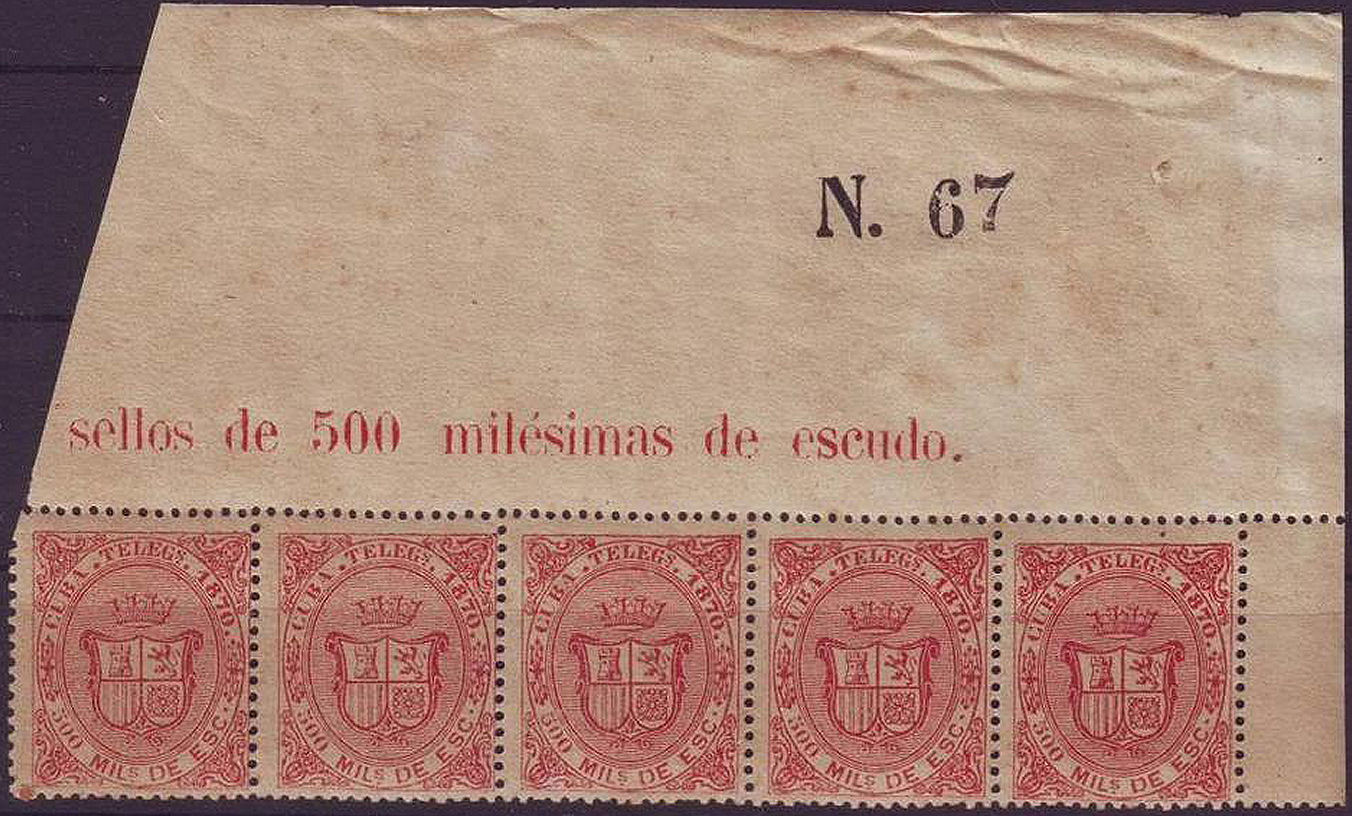
A strip of H14, courtesy of Adolfo Sarrias.
| Hisc. | Type. | 1870 Description | Mint | Used |
|---|---|---|---|---|
| H13 | 4 | 200m brown | 250.00 | 100.00 |
| H14 | 4 | 500m carmine | 5.00 | 3.75 |
| H14a | imperf. | 50.00 | - | |
| H15 | 4 | 1E blue | 5.00 | 3.75 |
| H16 | 4 | 2P grey-brown | 225.00 | 100.00 |
| H16a | imperf. | 500.00 | - |
1870 As above but dated "1870 A 71".
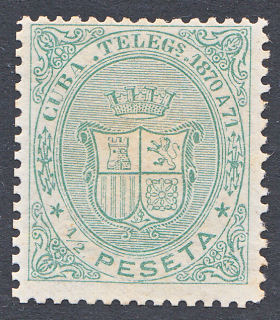 |
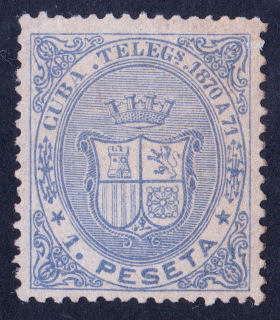 |
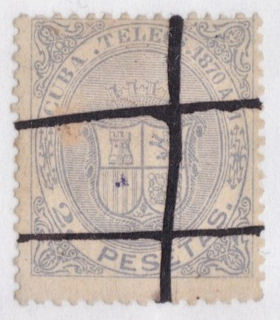 |
| Type 4 H17 | Type 4 H18 | Type 4 H19 - courtesy of Adolfo Sarrias. |
| Hisc. | Type. | Description | Mint | Used |
|---|---|---|---|---|
| H17 | 4 | ½p green | 75.00 | 35.00 |
| H18 | 4 | 1P ultramarine | 75.00 | 35.00 |
| H19 | 4 | 2P grey-lilac | 100.00 | 60.00 |
| H20 | 4 | 4P light red-brown | 200.00 | 60.00 |
Hiscocks added the following note:
| Note. A 200m essay is known (carmine) and colour-trials of the 2P are known in ultramarine, violet, brown, green and buff. |
1871 New design. White wove paper. No watermark. Perf. 14 (100c = 1P)
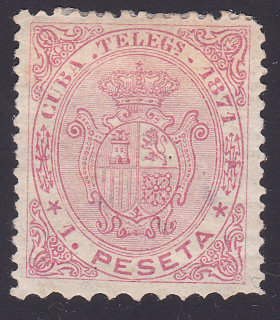 |
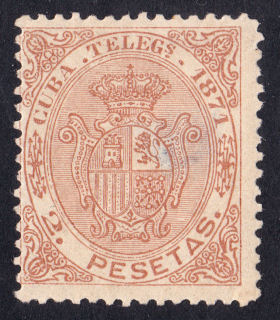 |
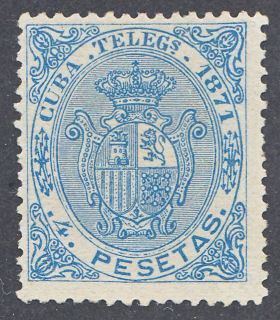 |
| Type 5 H22 | Type 5 H23 | Type 5 H25 |
| Hisc. | Type. | 1871 Description | Mint | Used |
|---|---|---|---|---|
| H21 | (5) | 50c green | 150.00 | 50.00 |
| H22 | (5) | 1P rose | 125.00 | 50.00 |
| H23 | (5) | 2P sepia | 125.00 | 50.00 |
| H23a | imperf. | 200.00 | - | |
| H24 | (5) | 2P mauve | 125.00 | 125.00 |
| H25 | (5) | 4P blue | 125.00 | 50.00 |
| H26 | (5) | 4P brown | 150.00 | 50.00 |
1872 As above but dated 1872.
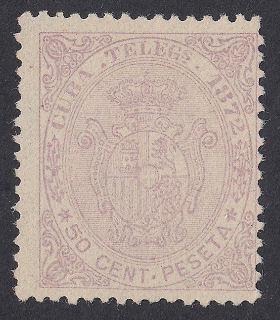 |
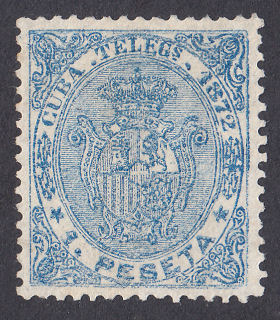 |
 |
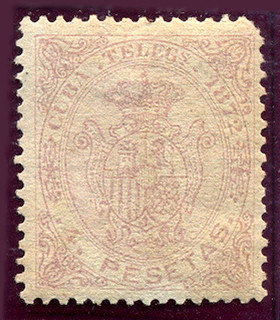 |
| Type 5, 1872 (H27) | Type 5, 1872 (H28) | Type 5, 1872 (H29) | Type 5, 1872 (H30) - from RL. |
| Hisc. | Type. | 1872 Description | Mint | Used |
|---|---|---|---|---|
| H27 | 5 | 50c mauve | 15.00 | 5.00 |
| H27a | lilac | 50.00 | 30.00 | |
| H28 | 5 | 1P blue | 7.50 | 3.75 |
| H29 | 5 | 2P green | 10.00 | 7.50 |
| H30 | 5 | 4P lilac (shades) | 7.50 | 3.75 |
1873 As above but dated 1873.
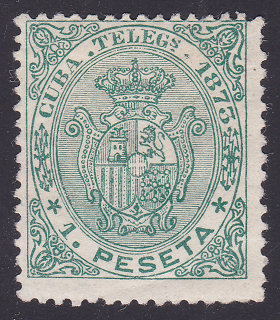 |
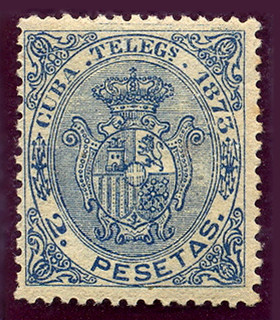 |
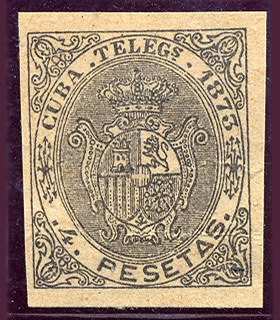 |
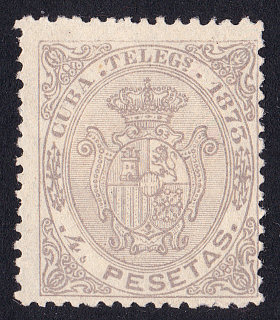 |
| Type 5, 1873 (H31) | Type 5, 1873 (H32) - from RL. | Type 5, 1873 (H33a) - from RL. | Type 5, 1873 (H33b) |
| Hisc. | Type. | 1873 Description | Mint | Used |
|---|---|---|---|---|
| H31 | 5 | 1P green | 5.00 | 3.75 |
| H32 | 5 | 2P blue | 7.50 | 5.00 |
| H33 | 5 | 4P lilac-grey | 125.00 | 40.00 |
| H33a | imperf. | 200.00 | - | |
| H33b | lilac | 150.00 | - |
1874 New crown, dated 1874.
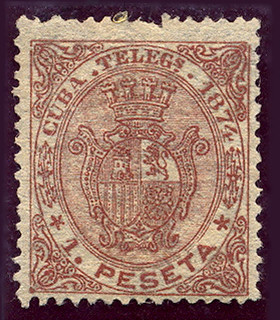 |
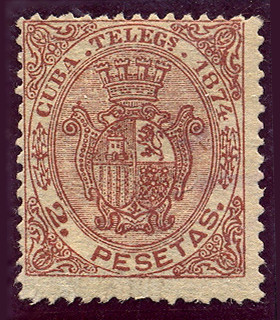 |
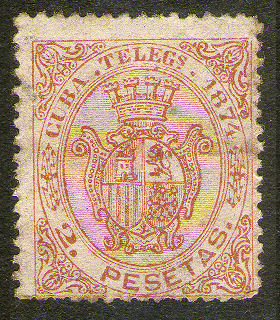 |
 |
| Type 5A, 1874 (H34) - from RL. | Type 5A, 1874 (H36) - from RL. | Type 5A, 1874 (H36) - mine | 1874 (H36a) - courtesy of Adolfo Sarrias. |
It seems strange to produce two values in the same colour !
| Hisc. | Type. | 1874 Description | Mint | Used |
|---|---|---|---|---|
| H34 | 5A | 1P red-brown | 20.00 | 7.50 |
| H34a | imperf. | 75.00 | - | |
| H35 | 5A | 1P carmine | 200.00 | 100.00 |
| H36 | 5A | 2P red-brown | 12.50 | 3.75 |
| H36a | imperf. | 75.00 | - | |
| H37 | 5A | 4P brown | 175.00 | 60.00 |
| H37a | imperf. | 225.00 | - |
Hiscocks also gave this note:
1875 New design without date. White wove paper. No watermark. Perf. 14.
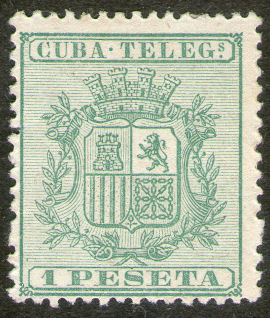 |
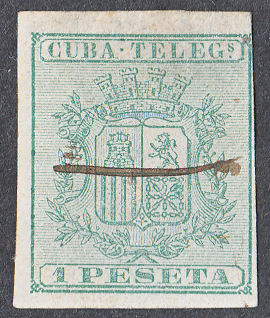 |
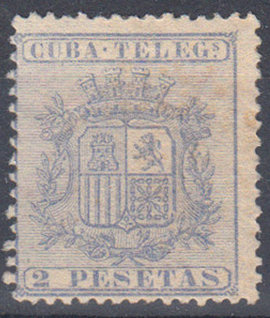 |
 |
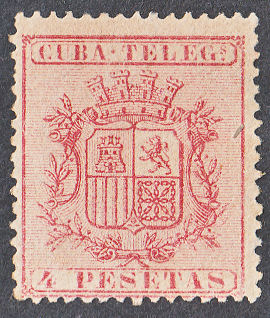 |
| Type 6, the One Peseta (H38) | Type 6, One Peseta imperf. (H38a) | Type 6, the 2 Peseta (H39) | Type 6, the 2 Peseta (H39b) | Type 6, the 4 Peseta (H40) |
| Hisc. | Type. | 1875 Description | Mint | Used |
|---|---|---|---|---|
| H38 | 6 | 1P green | 5.00 | 3.75 |
| H38a | imperf. | 25.00 | - | |
| H39 | 6 | 2P greyish blue | 5.00 | 3.75 |
| H39a | imperf. | 50.00 | - | |
| H39b | deep blue | 10.00 | 7.50 | |
| H39c | violet blue | 20.00 | 12.50 | |
| H40 | 6 | 4P carmine | 20.00 | 7.50 |
| H40a | imperf. | 60.00 | - |
1876 New design — Alfonso XII. Dated 1876. White wove paper. No watermark. Perf. 14.
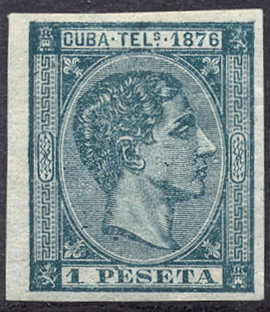 |
 |
| H41a - Courtesy of Rolf Lamprecht. | An 1876 selection, Type 7. Note that there are similar postage stamps with 'CORREOS' in the side panels, and without 'TELs'. |
| Hisc. | Type. | 1876 Description | Mint | Used |
|---|---|---|---|---|
| H41 | 7 | 1P bluish green | 3.75 | 3.75 |
| H41a | imperf. | 15.00 | - | |
| H42 | 7 | 2P darkish blue | 4.75 | 3.75 |
| H42a | lightish blue | 4.75 | 3.75 | |
| H42b | imperf. | 50.00 | - | |
| H43 | 7 | 4P carmine | 200.00 | 75.00 |
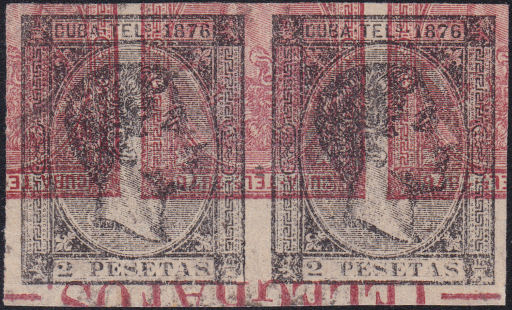

Printers waste?
(Maculatura) The 2P in black with an inverted 4p? in carmine. The back has indelible graffiti.
Hiscocks added the following note:
| Note. Stamps very similar to Nos. 42 and 43 but inscribed "TELEGRAFOS 1876" are from Puerto Rico. |
1877 New design dated 1877. White wove paper. No watermark. Perf. 14.
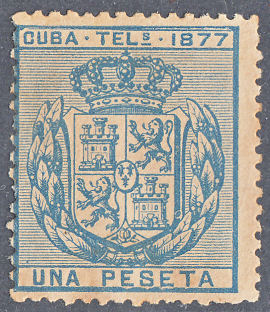 |
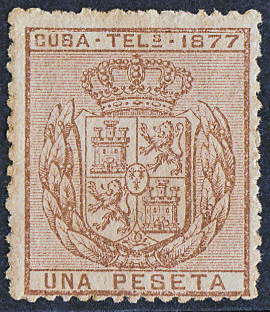 |
 |
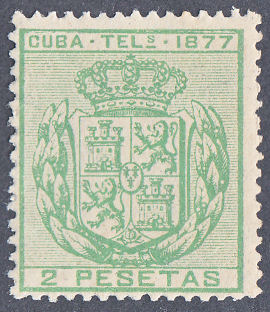 |
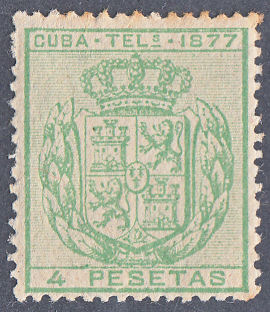 |
| 1877 1P, H44 | 1877 1P, H45 | 1877 1P, H45a | 1877 2P, H46 | 1877 4P, H48? |
| Hisc. | Type. | 1877 Description | Mint | Used |
|---|---|---|---|---|
| H44 | 8 | 1P blue (shades) | 5.00 | 3.75 |
| H44a | imperf. | 75.00 | - | |
| H45 | 8 | 1P red-brown | 10.00 | 5.00 |
| H45a | imperf. | 40.00 | - | |
| H46 | 8 | 2P light yellowish green | 7.50 | 3.75 |
| H46a | imperf. | 40.00 | - | |
| H46b | on yellowish paper | 10.00 | 5.00 | |
| H47 | 8 | 4P brown | 200.00 | 100.00 |
| *H48 | 8 | 4P light yellowish green | 12.50 | 5.00 |
| H48a | imperf. | 40.00 | - |
* S.E.R. Hiscocks said light blue and John Barefoot says pale blue.
The only 4P I have seen is the one shown (scanned with the 2P), described (correctly) by the seller as YVERT # 41A, given as green, same as the 2P.
1878 Similar to above but shield altered and dated 1878.
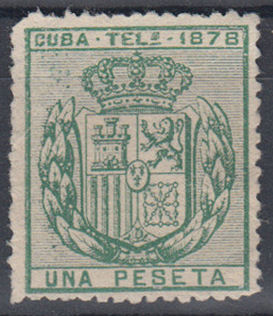 |
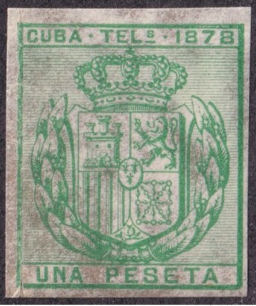 |
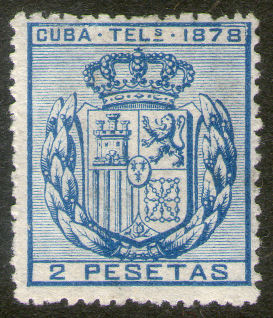 |
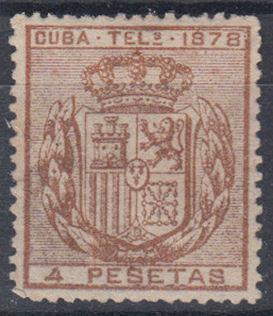 |
| H49, 1P courtesy of Peter Balner. | H49a, courtesy of Adolfo Sarrias. | 2 Peseta, H50 - one of mine. | H51, 4P courtesy of Peter Balner. |
| Hisc. | Type. | 1878 Description | Mint | Used |
|---|---|---|---|---|
| H49 | 9 | 1P yellow-green (shades) | 10.00 | 5.00 |
| H49a | imperf. | 40.00 | - | |
| H50 | 9 | 2P blue | 10.00 | 5.00 |
| H50a | imperf. | 40.00 | - | |
| H51 | 9 | 4P yellow-brown | 12.50 | 5.00 |
1879 As above but dated 1879.
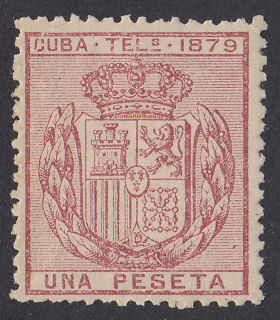 |
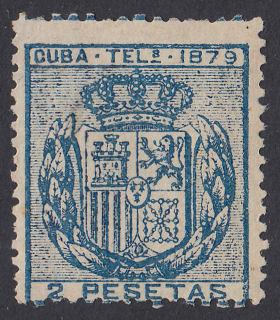 |
 |
| 1879 1P, H52 (Type 10) | 1879 2P, H53 (Type 10) | 1879 4P, H54 (Type 10) |
| Hisc. | Type. | 1879 Description | Mint | Used |
|---|---|---|---|---|
| H52 | 10 | 1P crimson to brown-lake | 6.00 | 5.00 |
| H53 | 10 | 2P blue to deep blue | 6.00 | 5.00 |
| H53a | error — bluish green | 120.00 | 100.00 | |
| H54 | 10 | 4P blue to bluish green | 10.00 | 5.00 |
| H54a | error — deep blue | 150.00 | 100.00 |
1880 As above but dated 1880.
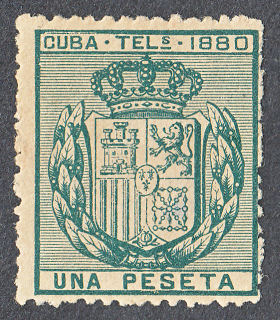 |
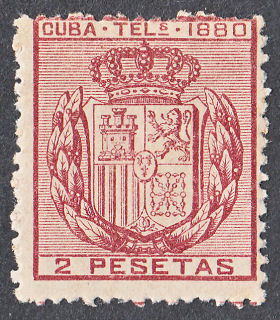 |
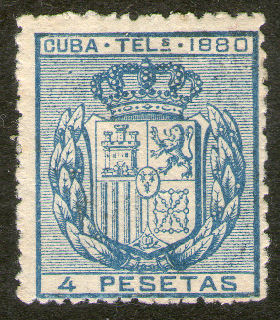 |
| 1880 1P, H55 (Type 11) | 1880 2P, H56 (Type 11) | 1880 4P, H57 (Type 11) |
| Hisc. | Type. | 1880 Description | Mint | Used |
|---|---|---|---|---|
| H55 | 11 | 1P myrtle green | 7.50 | 3.75 |
| H56 | 11 | 2P crimson | 7.50 | 3.75 |
| H57 | 11 | 4P blue to dark blue | 7.50 | 3.75 |
1881 As above but dated 1881. Values now in 'Centavos de Peso'.
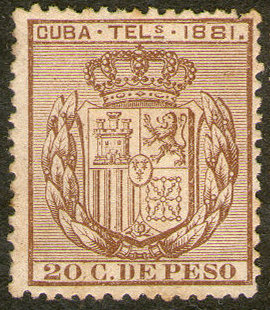 |
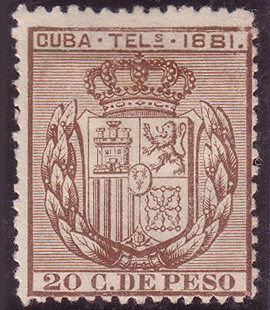 |
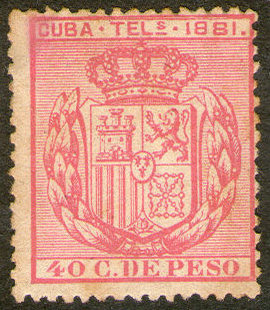 |
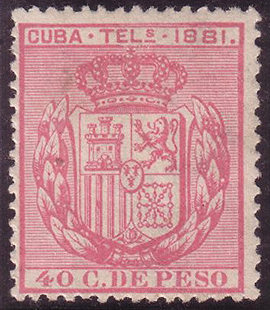 |
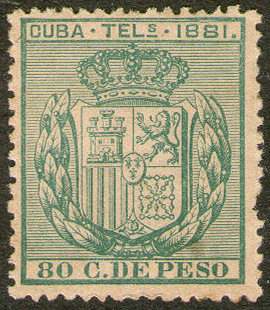 |
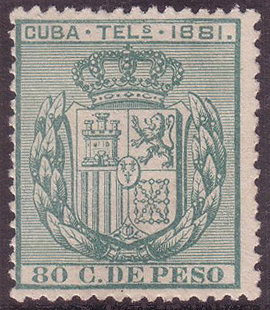 |
| 1881, Type 12 20c - one of mine. | 1881 20c - courtesy of Rolf Lamprecht. | 1881 40c - one of mine. | 1881 40c - courtesy of Rolf Lamprecht. | 1881 80c - one of mine. | 1881 80c - courtesy of Rolf Lamprecht. |
Personally, I think the colour given in the catalogue should reflect the colour of the ink. However it is often taken as the apparent colour. Ink is not opaque and the apparent colour is very dependent on the toning of the paper.
For mint stamps it can also depend on the colour of the gum that will also show through. Don't pay more for something because it has been kept in a poor environment.
| Hisc. | Type. | 1881 Description | Mint | Used |
|---|---|---|---|---|
| H58 | 12 | 20c brown | 7.50 | 3.75 |
| H58a | light yellowish brown | 15.00 | 7.50 | |
| H59 | 12 | 40c light rose | 7.50 | 3.75 |
| H59a | salmon-rose | 22.00 | 12.50 | |
| H59b | rose-carmine | 30.00 | 20.00 | |
| H60 | 12 | 80c bluish green | 10.00 | 5.00 |
| H60a | dark green | 50.00 | 50.00 |
An interesting item, this was advertised (on Delcampe) simply as "CUBA TELEGRAFOS Nº 53. CON CHARNELA." (with hinge).
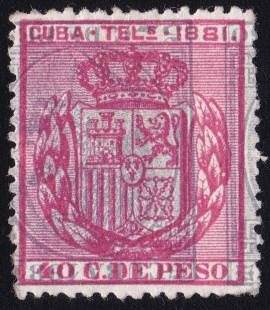 |
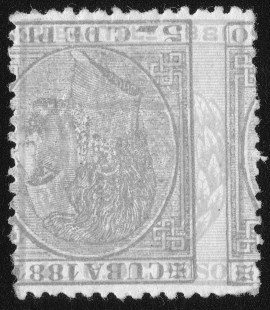 |
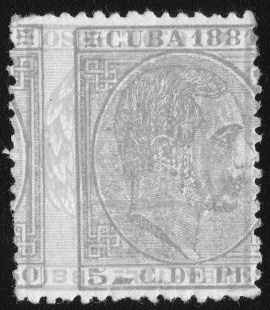 |
| 1881, H59 Double print ? | Blue-channel | Blue rotated - 5c 1881 Postage Stamp |
There is clearly a bit more to it than that. He does have some other items described as double-prints, but perhaps forgot on this.
Naturally I wanted to see what else was on it so split the colour channels and looked at the blue. Clearly not the same stamp (or colour).
Assuming this was not deliberately contrived, I can only assume that this were done by an offset process and the transfer roller wasn't cleaned between two different runs.
These are referred to as Maculatura and seem to be fairly common for Cuba. I can only assume that 'printers waste' was sold for profit rather than being destroyed.
Examples can also be found printed with stamps of Cuba and the Philippines combined. Presumably the printer in Spain could get away with selling colonial Maculaturas
in Spain, though I haven't seen Spanish ones. There are some dubious Spanish local issues though.
1882 As above but inscribed 'CUBA TELEGRAFOS' with no date.
 |
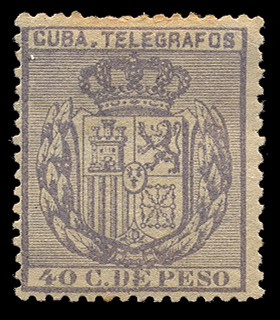 |
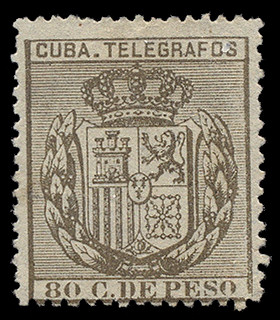 |
| Type 13 H61 - from RL. | Type 13 H62 - from RL. | Type 13 H63 - from RL. |
| Hisc. | Type. | 1882 Description | Mint | Used |
|---|---|---|---|---|
| H61 | 13 | 20c yellow-green | 10.00 | 3.75 |
| H62 | 13 | 40c grey-blue | 15.00 | 7.50 |
| H63 | 13 | 80c olive | 15.00 | 5.00 |
Hiscocks added the following note:
| Note. Apart from the provisionals of 1883 below, the remaining issues of the Spanish period up to 1896 were all of the same design (Type 13) and can only be allocated to their years of issue by their colour/value combinations. |
A range of colours were issued in 1882, 1884, 1888, 1890, 1892, 1894 and 1896.
Because of this I have provided a lookup-table to make life easier:
*Hiscocks listed two 20c dark browns. Barefoot says one is slightly darker than the other.
Yvert & Tellier list the 1896 20c as sepia, but the 1890 20c as dark violet (the same as they give for the 10c).
Looking at the reference collection of Eugenio de Quesada, I have amended the description of
the 1890 20c to dark violet-brown as there does appear to be a violet tinge to it.
1883 No. 62 above overprinted with the indicated design in carmine.
 |
| Overprints types 14 to 18 from Hiscocks page 85 |
Each sheet of 100 contains 12 of Type 14 and 22 each of the other types.
Type 14 is the first stamp in each row plus a couple of extras thrown in.
There are minor varieties of each and no consistent arrangement,
so that the complete layout would appear (to a cynics eye) to be arranged
to maximise the quantity of different blocks of four.
The minor varieties are due to the frame pattern not being completely symmetric. Even though the '40' may be
the right way up, types 15-18 can have the frame 180° out, and type 14 can be in 4 different orientations.
Further details can be found at the bottom of: www.agoradefilatelia.org, continuing on the next page.
The reason for this issue is that a large quantity of stamps were stolen from the Post Office of Havana on the night of April 9/10, 1883.
The theft included many denominations of postage stamps as well as the 40c 1882 Telegraph stamps.
The origin of the 'Arañitas' (spiders) control marks was a design used in for the Cuban Lottery tickets.
In multiples, these (and similar) made up the border and security background behind the lottery number.
According to John Barefoot these were overprinted on the stamps by "La Propaganda Literaria" in Havana.
Hiscocks added the following 2 notes:
| Note 1. All of the above varieties have been reported. It is perhaps surprising that there have apparently been no reports of double overprints in which one or both are inverted. |
| Note 2. The above overprints are usually poorly centred. They apparently derive from a similar range used on postage stamps in 1883 but with their values altered to '40'. |
1888 As above but with changed colours.
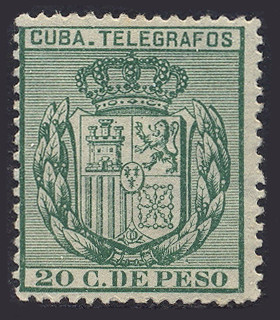 |
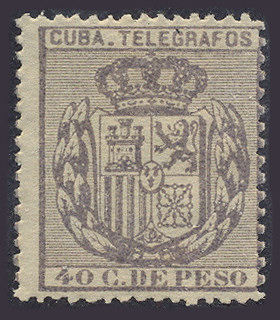 |
| Type 13 H72 - from RL. | Type 13 H73 - from RL. |
| Hisc. | Type. | 1888 Description | Mint | Used |
|---|---|---|---|---|
| H72 | 13 | 20c green | 20.00 | 15.00 |
| H73 | 13 | 40c pale-grey | 20.00 | 15.00 |
| H73a | used bisected on piece (2.9.89) | - | 125.00 |
Hiscocks added the following note:
1890 (January) As 1882 type, but with changed colours.
 |
 |
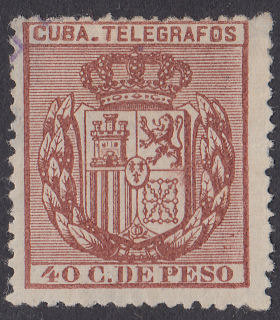 |
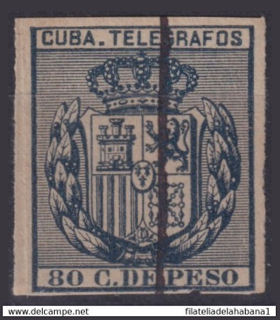 |
| Type 13 H74 - from RL. | Type 13 H76 - from RL. | Type 13 H77 | RH78c - courtesy of Adolfo Sarrias. |
| RH # | Hisc. | Type. | 1890 Description | Mint | Used |
|---|---|---|---|---|---|
| RH74 | H74 | 13 | 5c deep carmine (September 1890) | 10.00 | 5.00 |
| RH75 | H75 | 13 | 10c deep violet | 10.00 | 5.00 |
| RH75a | H75a | imperf. | 40.00 | - | |
| RH76 | H76 | 13 | 20c dark violet-brown | 10.00 | 5.00 |
| RH77 | H77 | 13 | 40c red-brown | 10.00 | 5.00 |
| RH77a | H77a | imperf. | 40.00 | - | |
| RH78 | H78 | 13 | 80c blue (September 1890) | 20.00 | 10.00 |
| RH78a | H78a | imperf. | 40.00 | - | |
| RH78b | H78b | deep blue | 30.00 | 15.00 | |
| RH78c | - | deep blue, imperf. | - | - |
1892 As 1882 type, but with changed colours.
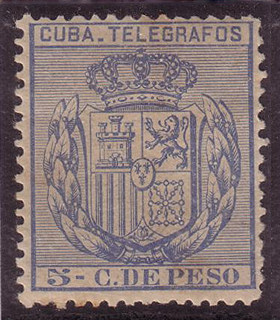 |
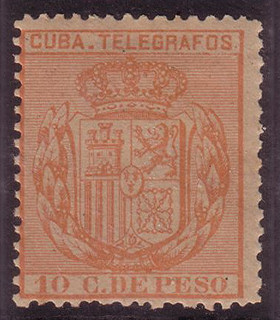 |
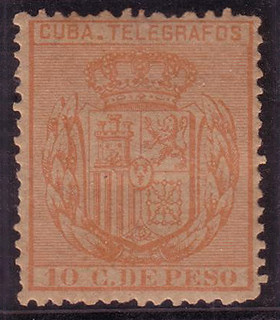 |
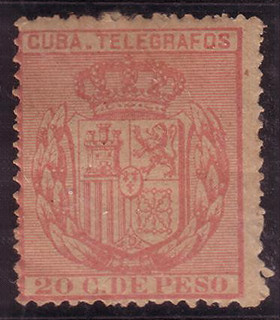 |
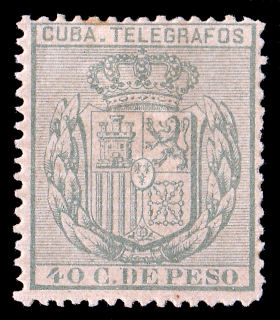 |
| Type 13 H79 - from RL. | Type 13 H80 - from RL. | Type 13 H80a - from RL. | Type 13 H81a - from RL. | Type 13 H82 |
| Hisc. | Type. | 1892 Description | Mint | Used |
|---|---|---|---|---|
| H79 | 13 | 5c light blue | 15.00 | 5.00 |
| H80 | 13 | 10c yellow-orange | 10.00 | 3.75 |
| H80a | red-orange | 50.00 | 20.00 | |
| H81 | 13 | 20c salmon-rose | 30.00 | 15.00 |
| H81a | rose | 50.00 | 25.00 | |
| H82 | 13 | 40c light greyish green | 15.00 | 5.00 |
1894 As 1882 type, but with changed colours.
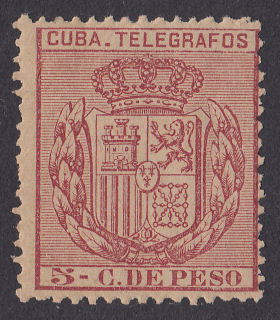 |
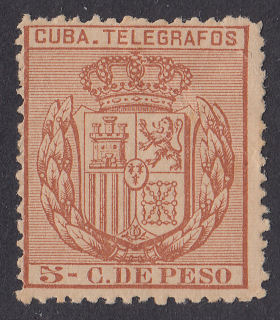 |
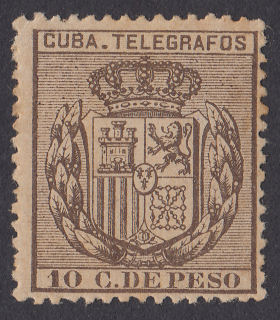 |
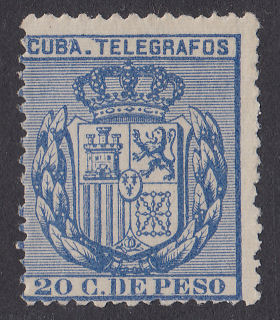 |
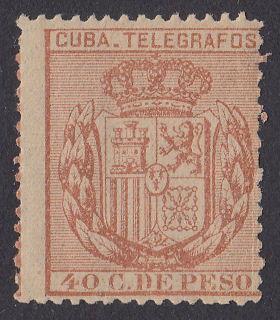 |
| Type 13 H83 | Type 13 H83b | Type 13 H84 | Type 13 H85 | Type 13 H86 |
| Hisc. | Type. | 1894 Description | Mint | Used |
|---|---|---|---|---|
| H83 | 13 | 5c deep red-brown | 5.00 | 2.50 |
| H83a | imperf. | 125.00 | 125.00 | |
| H83b | light red-brown | 5.00 | 2.50 | |
| H84 | 13 | 10c brown-black | 5.00 | 2.50 |
| H84a | imperf. | 125.00 | 125.00 | |
| H85 | 13 | 20c blue | 5.00 | 2.50 |
| H85a | imperf. | 125.00 | 125.00 | |
| H86 | 13 | 40c light red-brown | 5.00 | 2.50 |
| H86a | imperf. | 125.00 | 125.00 |
1896 As 1882 type, but with changed colours.
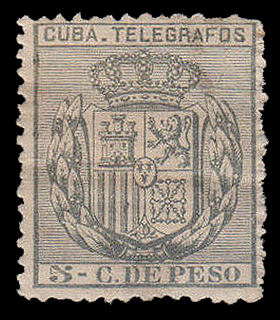 |
 |
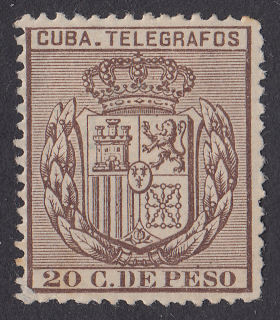 |
 |
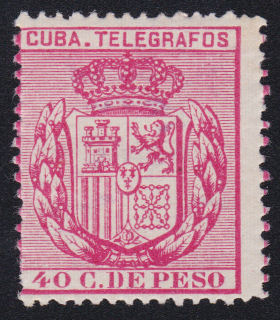 |
| Type 13 H87 courtesy of Peter Balner | Type 13 H88 | Type 13 H89 | Type 13 H89 Muestra. Courtesy of Adolfo Sarrias |
Type 13 H90 |
The 20c Muestra (Specimen) seems to have a double-touch at the top. Perhaps this was produced manually on a small press.
| Hisc. | Type. | 1896 Description | Mint | Used |
|---|---|---|---|---|
| H87 | 13 | 5c greyish green | 7.50 | 3.75 |
| H87a | imperf. | 125.00 | - | |
| H88 | 13 | 10c dark slate-blue | 7.50 | 3.75 |
| H88a | imperf. | 125.00 | - | |
| H89 | 13 | 20c dark brown | 7.50 | 3.75 |
| H89a | imperf. | 125.00 | - | |
| H90 | 13 | 40c rose (shades) | 7.50 | 3.75 |
| H90a | imperf. | 125.00 | - |
Hiscocks added the following note:
| Note. Care has been taken with the above issues. The only real problems are the 20c of 1890 and 1896 (Nos. 76 and 89): there may well be a shade difference to distinguish them and a minority of copies do in fact appear 'redder' in tone than others (No. 76?) but I have been unable to locate a copy of the imperforate variety of No. 89 which would unambiguously identify an 1896 copy and allow comparison with the other 'dark brown' specimens. Assistance would be welcome. |
1898 As in Spain, it had been decided to provide stamps for combined 'Correos y Telegrafos'.
By this time, the punching of telegraph stamps had ceased and usage can only be identified by the cancel used.
The USA declared war on Spain on 20/21 April 1898. This led to the Treaty of Paris and Spanish withdrawal, completed by the end of 1898.
Whatever stamps they had at that point, had to last them a long time.
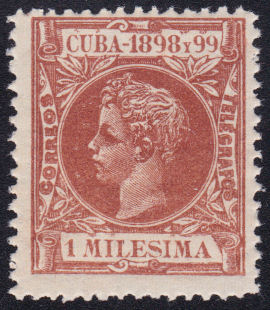 |
 |
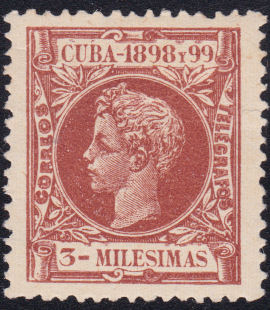 |
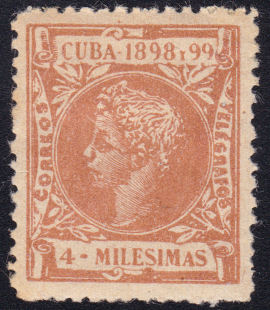 |
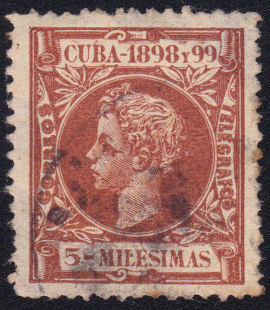 |
| Type CyT, C1 | Type CyT, C2 | Type CyT, C3 | Type CyT, C4 | Type CyT, C5 |
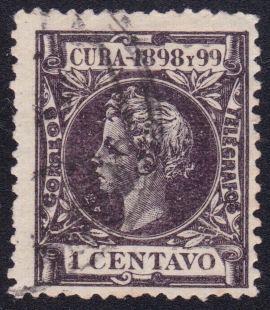 |
 |
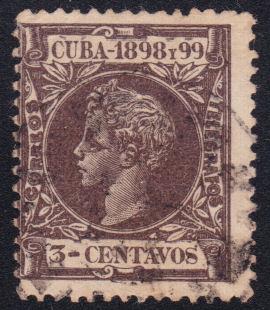 |
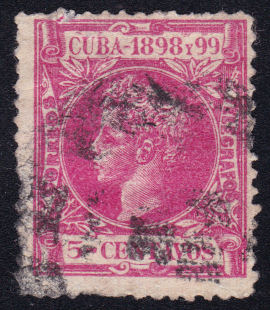 |
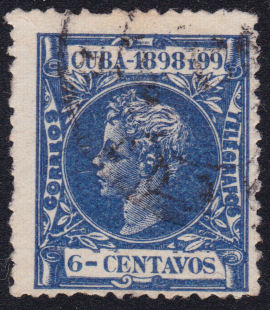 |
| Type CyT, C6 | Type CyT, C7 | Type CyT, C8 | Type CyT, C10 | Type CyT, C11 |
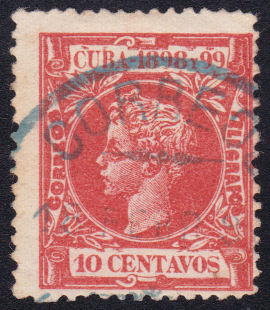 |
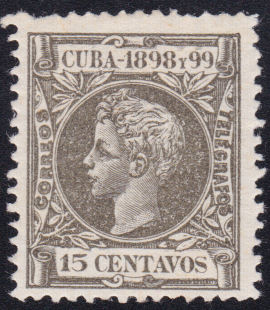 |
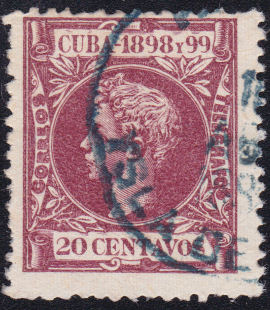 |
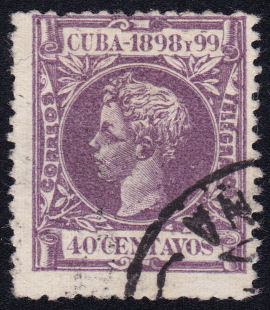 |
| Type CyT, C13 | Type CyT, C14 | Type CyT, C15 | Type CyT, C16 |
| RH # | Type. | 1878 Description | Mint | Postally Used | Telegraphically Used |
|---|---|---|---|---|---|
| C1 | CyT | 1m orange-brown (shades) | 0.20 | 0.20 | - |
| C2 | CyT | 2m orange-brown (shades) | 0.20 | 0.20 | - |
| C3 | CyT | 3m orange-brown (shades) | 0.20 | 0.20 | - |
| C4 | CyT | 4m orange-brown (shades) | 3.00 | 1.50 | - |
| C5 | CyT | 5m orange-brown (shades) | 0.20 | 0.20 | - |
| C6 | CyT | 1c violet black | 0.20 | 0.20 | - |
| C7 | CyT | 2c turquoise | 0.20 | 0.20 | - |
| C8 | CyT | 3c dark brown | 0.20 | 0.20 | - |
| C9 | CyT | 4c orange | 10.00 | 4.00 | - |
| C10 | CyT | 5c carmine-rose | 1.00 | 0.20 | - |
| C11 | CyT | 6c dark blue | 0.20 | 0.20 | - |
| C12 | CyT | 8c grey-brown | 0.80 | 0.50 | - |
| C13 | CyT | 10c vermilion | 0.80 | 0.40 | - |
| C14 | CyT | 15c olive-green | 3.00 | 0.40 | - |
| C15 | CyT | 20c maroon | 0.45 | 0.20 | - |
| C16 | CyT | 40c violet | 1.75 | 0.35 | - |
| C17 | CyT | 60c black | 1.75 | 0.35 | - |
| C18 | CyT | 80c brown-lilac | 10.00 | 6.00 | - |
| C19 | CyT | 1P light green | 10.00 | 6.00 | - |
| C20 | CyT | 2P slate-blue | 20.00 | 6.50 | - |
According to the Scott catalogue, the values below 1c were used on newspapers.
They also say that these all exist imperf and quote US $1500 for unused pairs.
They go on to list 13 different overprints ranging from 1c to 10c that were applied to these
mostly in black to values less than 1c, but some in red on the 1c value.
Overprints were also applied to existing Newspaper stamps.
Cuba clearly valued it's newspapers. There are also forged and bogus overprints about.
Having liberated Cuba from Spain, the USA went on to ensure adequate supplies of stamps.
Initially this was with overprinted U.S. stamps, but very soon with purpose made ones.
The first issue of postage stamps for the Republic of Cuba was 30 September 1902.
By 1910 when new Telegraph stamps were produced, they were being given normal postal cancels.
It is likely that this started at an early date, since I have not heard of any telegraphic examples being reported.
| According to www.agoradefilatelia.org: 'No stamps from 1899 to 1909. Cuba did not issue telegraph stamps during the early years of the United States Administration or in the Republic until 1910. During this period, regular postage stamps with special telegraphic cancellation were used to cover the needs of the Telegraph. The Telegraph Service of Cuba ceased to operate on December 31, 1923.' |
Stamps used telegraphically from 1899 to 1909 can only be recognised by their cancel.
The set had values of 1c, 2c, 3c, 5c and 10c. A re-engraved set was issued in 1905 with small differences.
A 50c stamp was issued in 1907. Subsequent postage stamps were inscribed 'CORREOS', whereas the 1899 to 1907 issues were not.
Image courtesy of Les Bottomley.
1910 Cuban Republic issues. White wove paper. No watermark. Perf. 12.
Printed by the American Bank Note Co. N.Y.
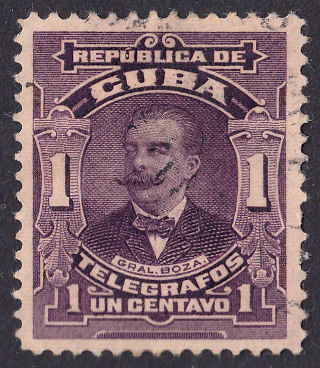 |
 |
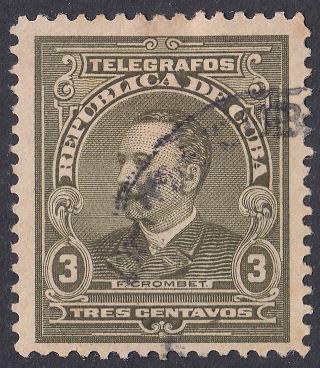 |
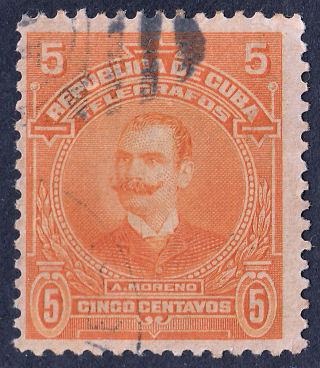 |
| Type 22 - H94 | Type 19 - H91 | Type 20 - H92 | Type 21 - H93 |
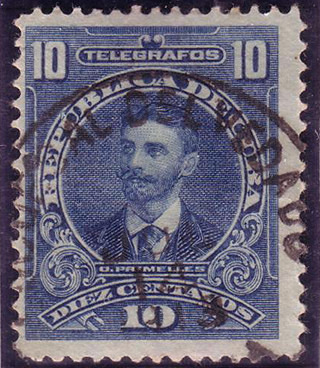 |
 |
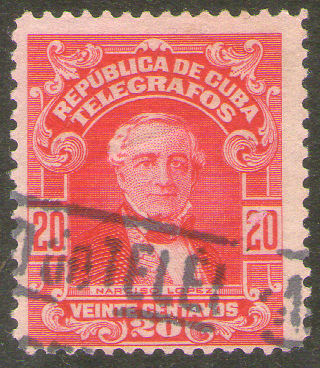 |
 |
| Type 23 - H95 - from RL. | Type 23 - H95a | Type 24 - H96 | Type 25 - H97 |
1911 As 1910 but with changed colours.
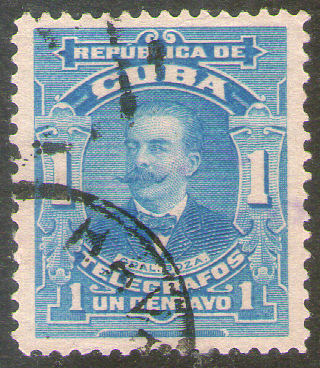 |
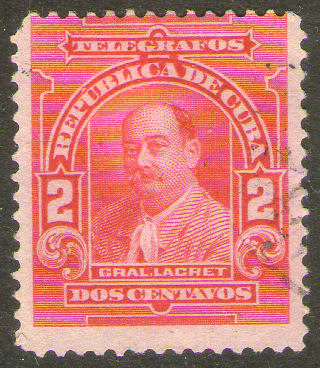 |
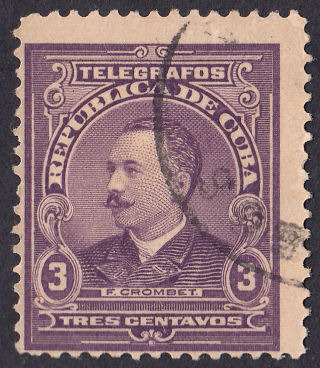 |
| Type 19 - H98 | Type 20 - H99 | Type 21 - H100 |
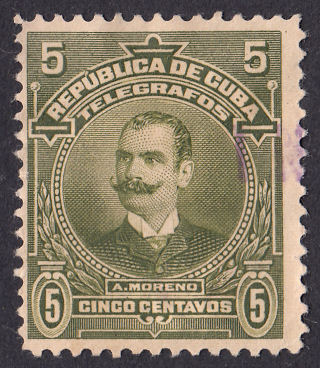 |
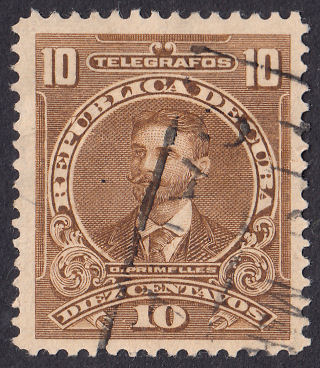 |
 |
| Type 22 - H101 | Type 23 - H102 | Type 25 - H103 |
1916 New design. White wove paper (surface tinted to varying degrees in colour of stamps).
No watermark. Perf. 12
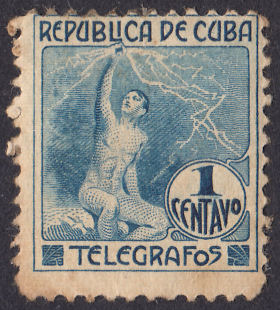 |
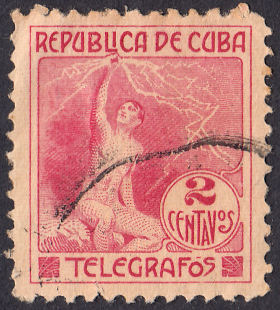 |
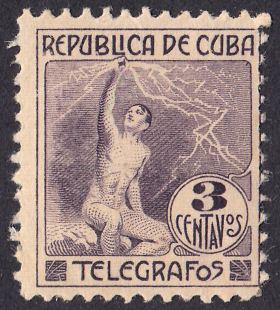 |
| Type 26 - H104 | Type 26 - H105 | Type 26 - H106 |
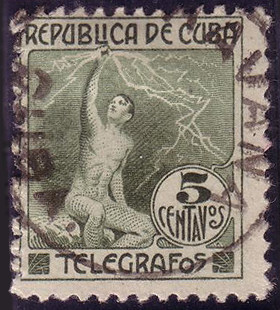 |
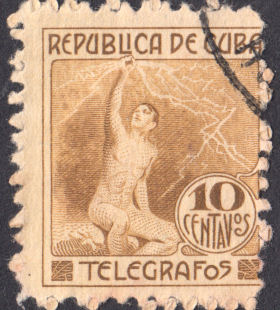 |
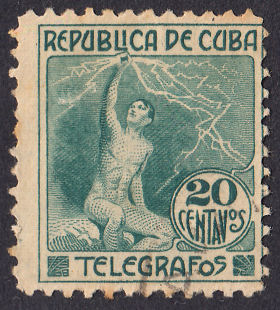 |
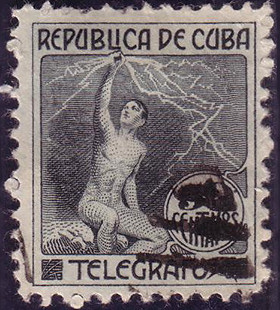 |
| Type 26 - H107 - from RL. | Type 26 - H108 | Type 26 - H109 | Type 26 - H110 - from RL. |
Other.
Ultramar. (meaning Overseas)
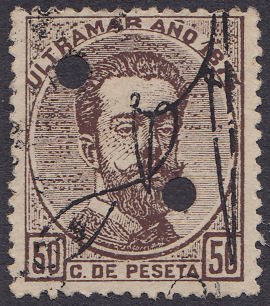
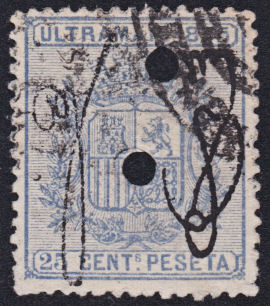

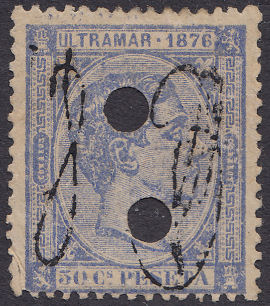
These were issued over the period 1873 to 1876 and used in Cuba as well as Puerto Rico, where more examples are shown and information given.
The holes are normally taken to indicate telegraphic use.
It would seem that in addition to the above, normal postage stamps were used for telegraphic purposes when telegraph stamps were not available.
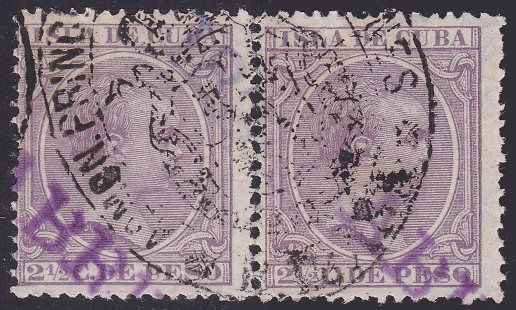 |
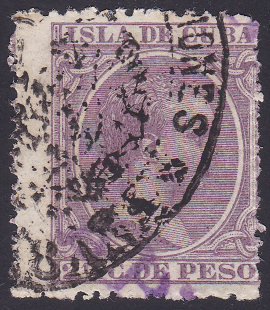 |
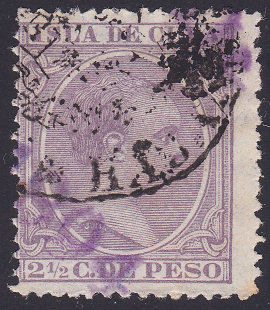 |
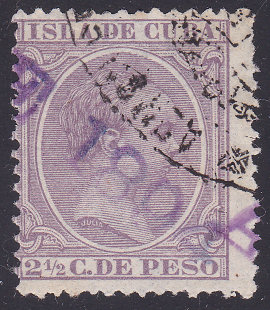 |
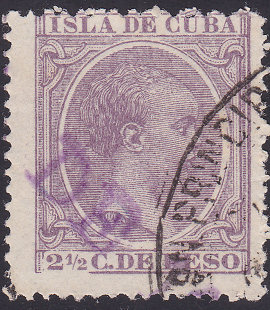 |
| Examples of the 1894 issue 2½c, the second and fifth showing the day of the month was not included. The last has an interesting frame break below the value. | ||||
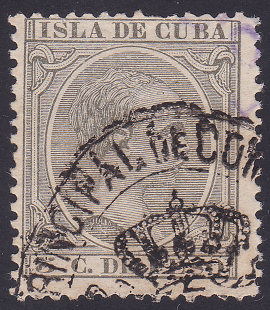 |
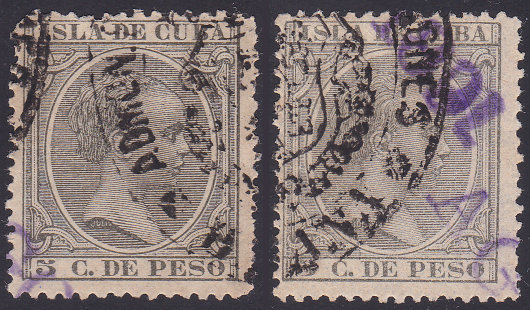 |
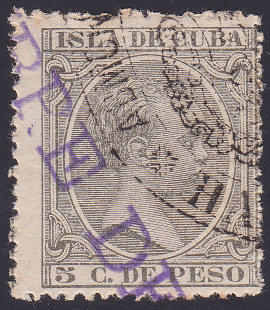 |
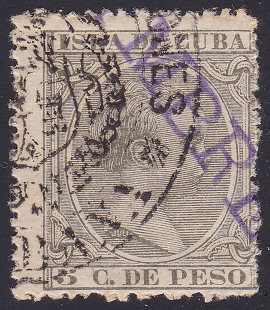 |
| Examples of the 1890 issue 5c. The third shows that the day of the month was not included. | |||
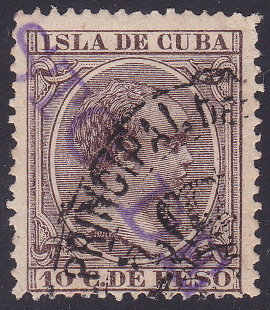 |
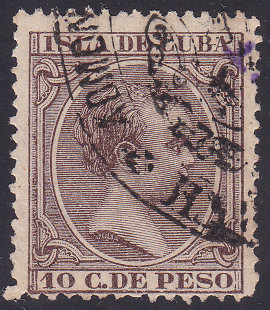 |
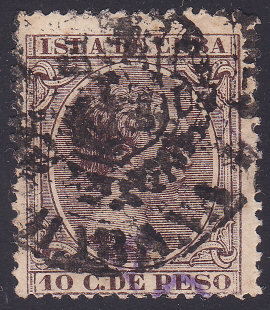 |
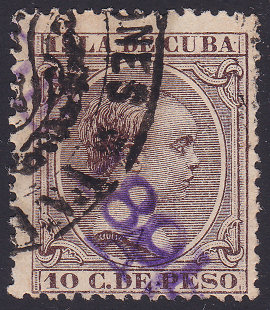 |
| Examples of the 1890 issue 10c. | |||
Telephone Stamps.
Date ? For Long Distance Service. Litho. by American Bank Note Co., New York.
Perf. 11¾ in panes of 10. All the ones I have seen have a straight edge at either the top or bottom.
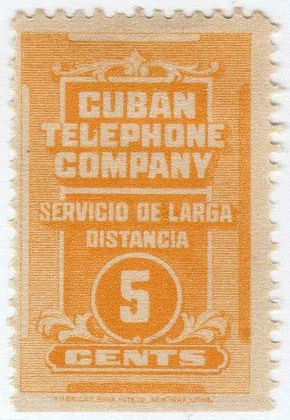 |
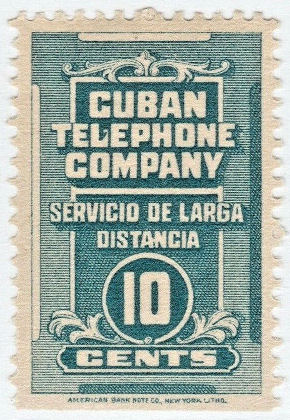 . . |
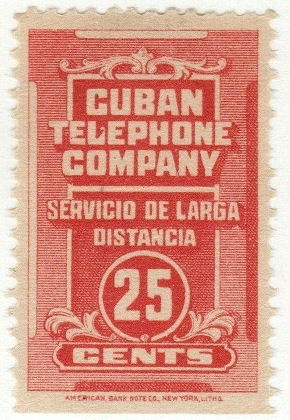 |
| Type 27 - 5c. | Type 27 - 10c. | Type 27 - 25c. |
| Images courtesy of Jerry (Treasurings Jewelry on eBay, click for listing). | ||
| RH # | Type. | Description | Mint | Used |
|---|---|---|---|---|
| RH T1 | 27 | 5c orange | - | - |
| RH T2 | 27 | 10c blue-green | - | - |
| RH T3 | 27 | 25c red | - | - |
These are all described as being from booklet panes and being without gum.
The Christie's (N.Y.) sale of A.B.N.Co Archives of September 12, 1990, lot 341 offered
"Telephone, booklet containing special 5c (50), 10c (50) and 25c (10) Telephone Company stamps valid for payment for long distance calls, each in
panes of ten, all stamps overprinted with diagonal 'Specimen' in red and with security punch, archival handstamp on front cover". The estimate was $500-700.
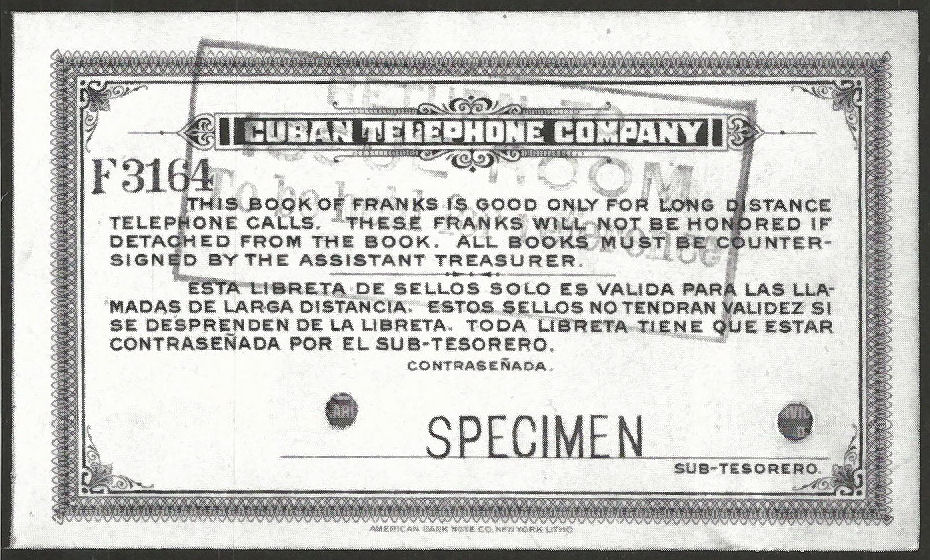
I would be interested to hear from anyone with further information on these.
Stationery.
(click on images for listing)
An 1861 Despacho telegráfico.
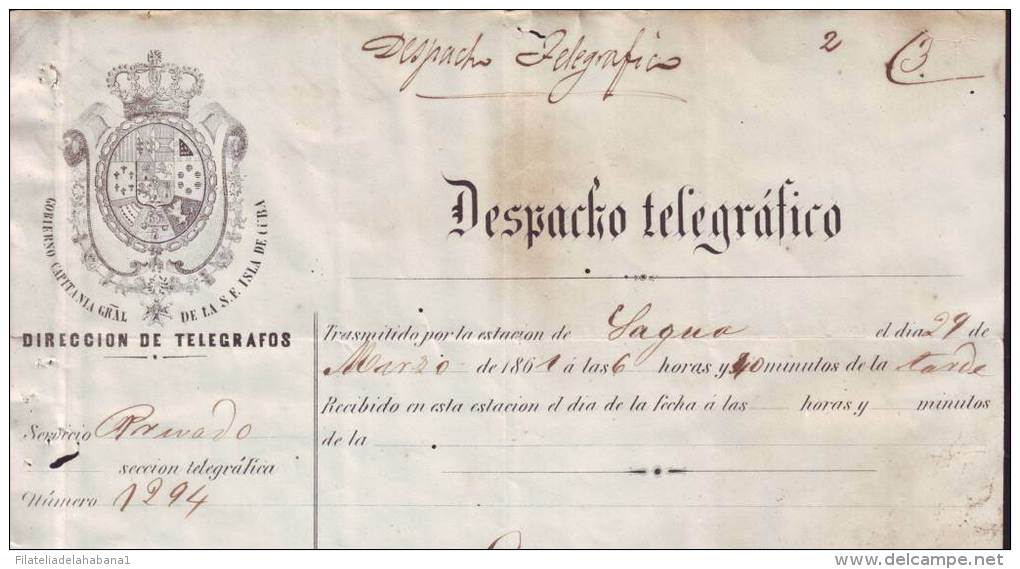
Image courtesy of Adolfo Sarrias
1861 ? A very similar Despacho telegráfico, but I'm unsure of the year.
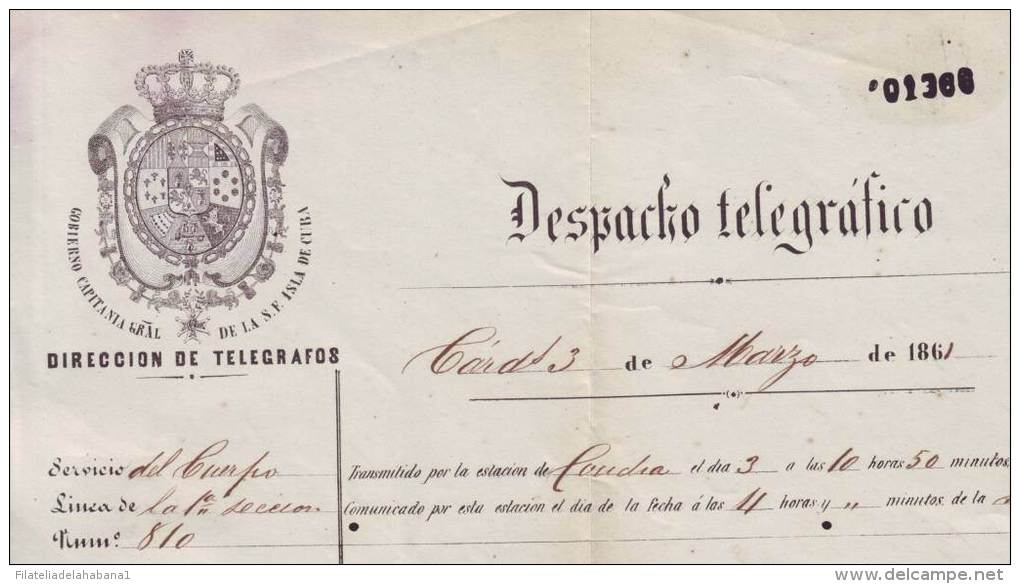
Image courtesy of Adolfo Sarrias
An 1874 Telégrama.
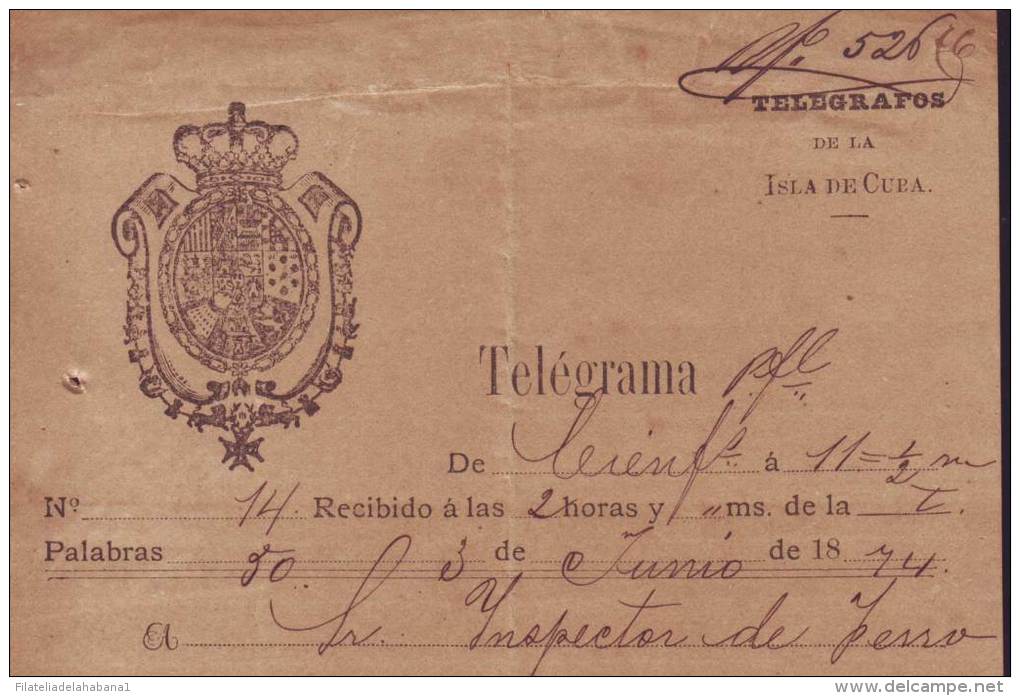
To the Inspector of Railways ('Ferro.' short for Ferrocarril = Railway), 50 words about a derailment. - Image courtesy of
Adolfo Sarrias
A similar 1877 Telégrama with higher quality coat of arms.
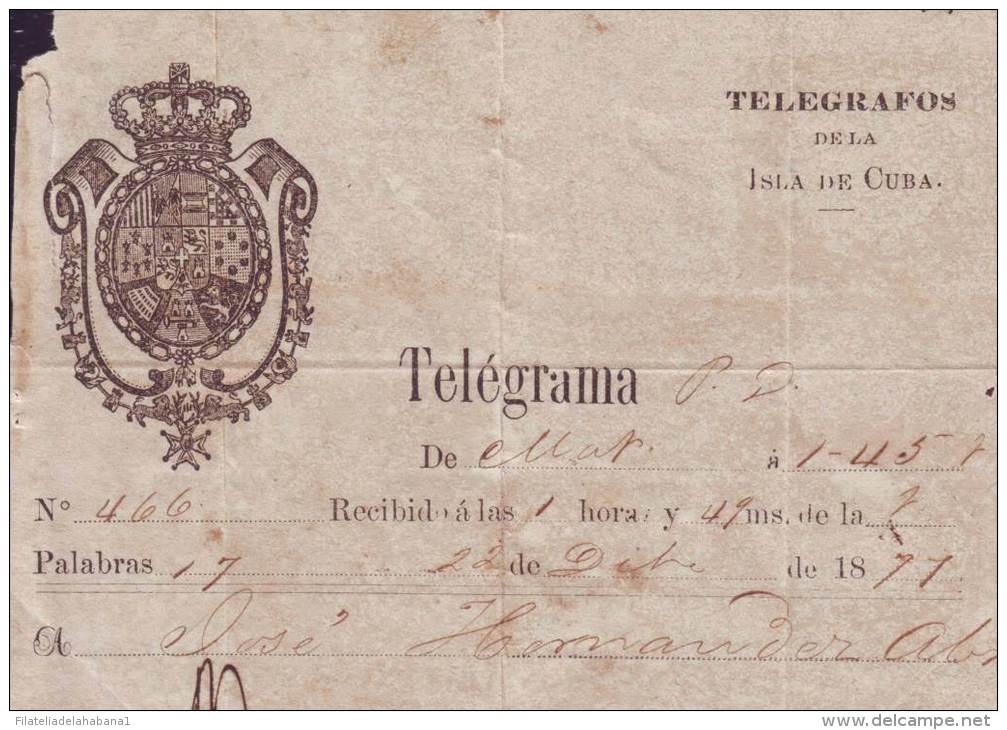
Image courtesy of Adolfo Sarrias
A 1887 Comunicaciones Telegrafos.
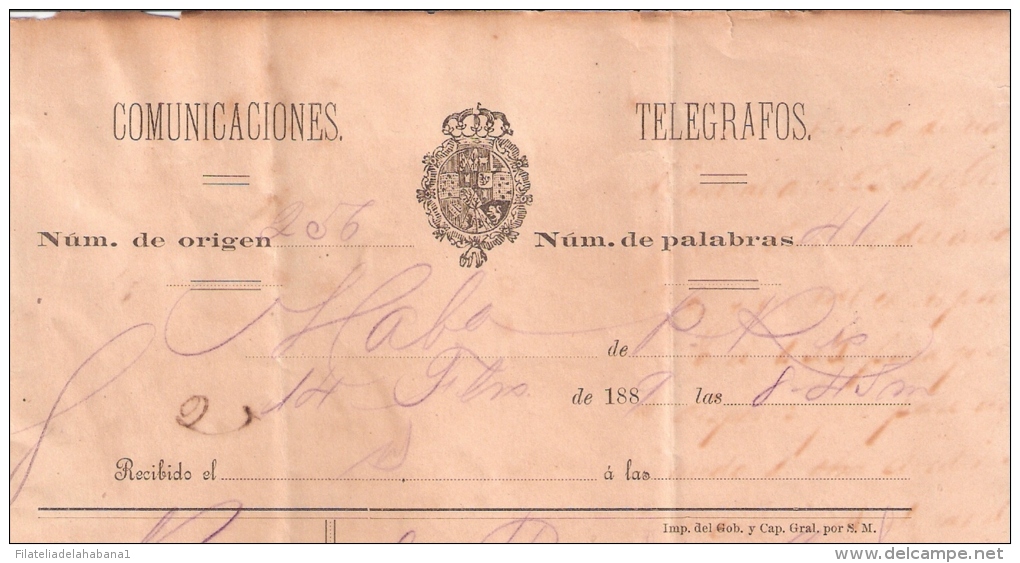
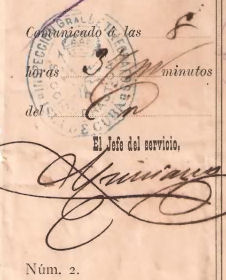
Though not explicitly saying 'Cuba' at the top anymore, the handstamp does lower down.
Image courtesy of Adolfo Sarrias
A 1897 Cuerpo de Comunicaciones de la Isla de Cuba ('Cuerpo' = Body).

The crest at the top is totally changed and is similar to the hand-stamp on the item above. This is shortly before Spanish forces withdrew from the Island.
Image courtesy of Adolfo Sarrias
This is headed "West India and Panama Telegraph Co." This company laid many cables around the Caribbean.
This was for a telegram from Cuba to Ponce on 15 May 1883.
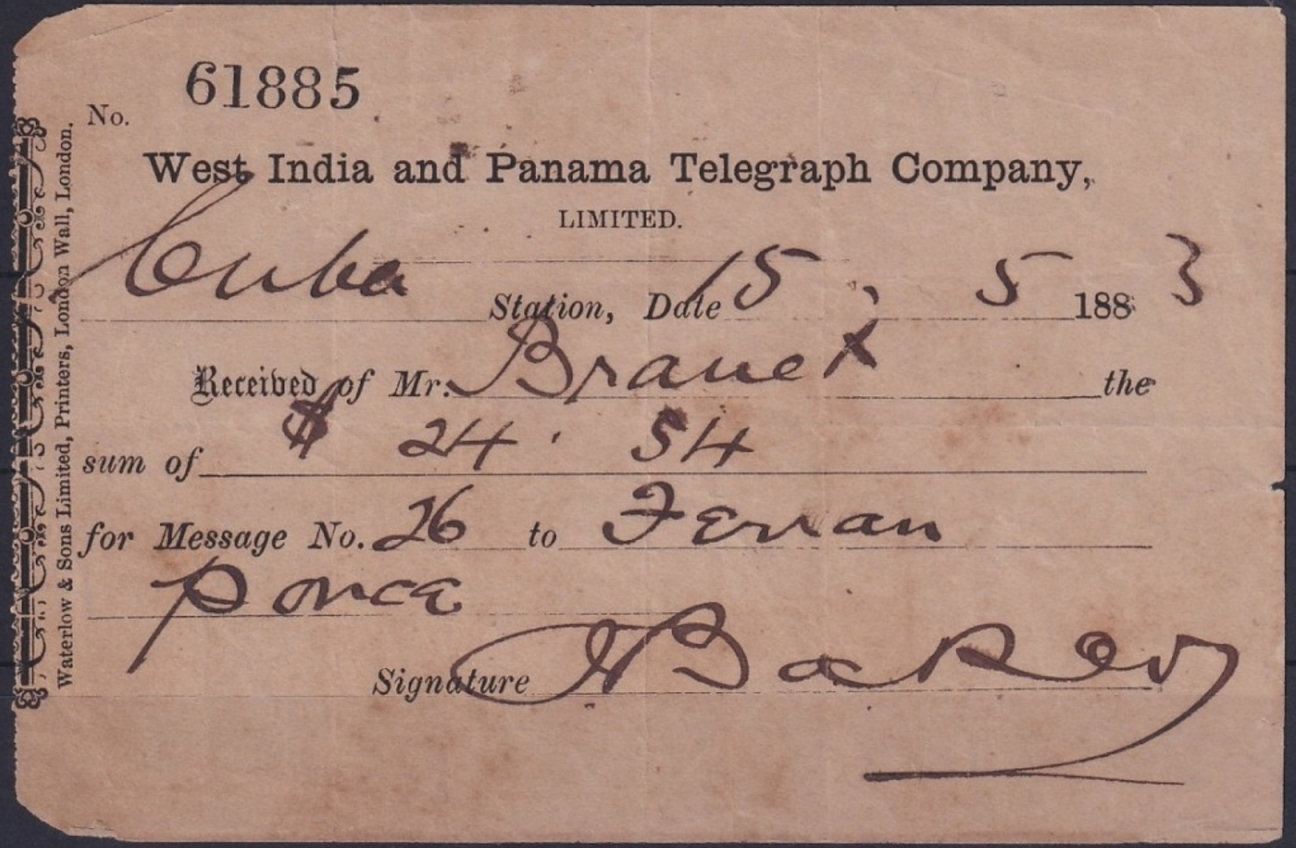
This was printed by Waterlow & Sons of London Wall.
If anyone can provide scans to help with this, I am happy to give appropriate credit.

